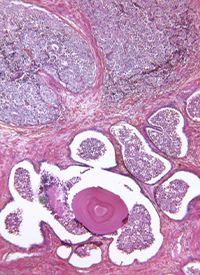MRI, PCA3 Tests Are Reliable Indicators of Prostate Biopsy Positivity
Both magnetic resonance imaging and prostate cancer antigen 3 tests can predict a positive prostate biopsy and are helpful in identifying high-risk prostate cancer.

Both magnetic resonance imaging (MRI) and prostate cancer antigen 3 (PCA3) tests can predict a positive prostate biopsy and are helpful in identifying high-risk prostate cancer, according to a retrospective study presented at the 2017 meeting of the Society of Urologic Oncology, held in Washington, DC.
It has previously been shown that rising PCA3 scores correlate to prostate biopsies that are positive for cancer, independent of prostate size or prostate-specific antigen levels. Further, MRI screening has shown accuracy in detecting high-grade prostate cancer.
The purpose of the study was to analyze the clinical effectiveness of using both findings from MRI and PCA3 screening to predict adverse pathology from a prostate biopsy. This is an important determination, as prostate biopsies are associated with a host of adverse events (AEs), including bleeding, risk of infection, and pain. There is considerable concern among urologists that conducting unnecessary biopsies can harm patients If there are accurate, noninvasive techniques that can predetermine which patients will need a biopsy, the number of unnecessary biopsies can be reduced, as well as the incidence of these AEs.
“Using both tests does not increase the likelihood of identifying men with prostate cancer. However, the combined use of MRI and PCA3 does help to identify men without PCA. Therefore, implementing both tests in clinical practice may decrease the number of unnecessary biopsies performed,” Courtney Berg and colleagues wrote in their abstract.
The investigators retrospectively reviewed the treatment of 149 patients at Winthrop University Hospital in Mineola, New York, who each received an MRI, PCA3 test, and a prostate biopsy. An abnormal MRI result was defined as any suspicion of the presence of prostate cancer within or surrounding the prostate, and a positive PCA3 test was defined as a score of 25 or greater. Then they analyzed the data to determine an abnormal MRI, a positive PCA3 test, and Gleason scores from biopsies were related.
The average age of the patients at the time of biopsy was 65 (range, 43-82). The average time elapsed between a PCA3 test and a biopsy was 2 months, with 1.7 months being the average between an MRI and a biopsy.
In terms of accurately predicting a positive prostate biopsy, the MRI had an accuracy of 60%, a sensitivity of 83%, and a specificity of 29%. PCA3 status correctly predicted positive biopsies 62% of the time with a sensitivity of 81% and specificity of 37%. When combining MRI and PCA3 tests, specificity increased to 60% and sensitivity decreased to 66%, with 64% accuracy.
MRIs and PCA3 tests have comparable accuracy for predicting a positive prostate biopsy, and so both were determined to be useful in this space. However, the researchers determined that these tests cannot substitute for a definitive tissue biopsy test when it comes to diagnosing the presence of prostate cancer.
Berg C, Halpern D, Fazzari M, et al. Utilization of MRI and PCA3 reduces unnecessary prostate biopsies. Poster presented at: 2017 SUO Annual Meeting; November 29-December 1, 2017; Washington, DC. Poster #92.



